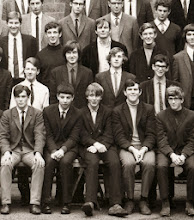So to the corrections, which I hope will be made in a reprint before long….sorry, first, that I spectacularly muddled James Herriot’s choice of hymn lines in the quotation which begins Chapter 8 (Page 261) by calling his most famous book All Things Bright and Beautiful. It is actually All Creatures Great and Small.

Thanks very much to my blog correspondent Lingard (see post Paved with - Huddersfield below) for pointing that out. Also see Richard Carter's comment on this post, putting right my geography of Port Sunlight and Phil Dawson's on the very first post, right at the bottom, correcting St James's Park to the proper St James' Park (on Page 11).
Thanks to all; and to to Steve Burkeman of the Rowntree Society for noticing that on Page 275, I rename York’s Quaker-founded psychiatric hospital, The Retreat, as The Mount, which is the city’s Quaker girls school (and alma mater of Margaret Drabble and Dame Judi Dench among others). I should know, because my sisters Hilary (editor of Red Pepper) and Tessa, wise teacher of English as a foreign language in Bradford, are alumni too.
Now, thanks to my wife Penny’s eminent cousin Prof Paul Cartledge (whose books, like Hilary’s, are all must-buys). He kindly puts me right on the following:
Page 54 The Latin version of Yellow Submarine sung to the House of Commons by Derek Enright MP should use ‘natali’ and not ‘natalis’. I am not going to argue with Cambridge University’s A G Leventis Professor of Greek Culture about that.
Page 75 The Barnsley fashion business Pollyanna mysteriously loses it second ‘l’ in the two references to it on this page. Opposite, on Page 74, I get it right.
Page 137 The word ‘the’ has gone missing before ‘triumphs’
Page 156 ‘does’ should be ‘do’ in second para – not for the first time, I gave plural subjects a singular verb.
Page 163 The 's' of 'Guardian's' should be roman and not italic
Page 204 In a repeat of my Pollyanna eccentricities, I have mis-spelt the first name of Leeds’ great race relations pioneer Erroll James, using only one ‘l’, whereas I get it right on the page opposite. Something bout ‘l’s in my psyche…
Page 209 ‘premier’ should hve a concluding ‘e’
Page 234 I rechristened the writer Alan Sillitoe ‘David’. The wonderfully meticulous Paul asks: “Is this confusion with David Storey?” No. It’s confusion with Alan’s son David, one of the best photographers working for the Guardian and an ace companion on jobs.
Page 238 I should have given Richard Hoggart his first name, as this is the first mention of him (surprisingly; maybe I cut something earlier out). He also isn’t in the index.
Page 285 The word enthusiastic mysteriously appears as two: enthus and iastic. We will get that gap closed.
Page 289 ‘makes’ should be ‘make’ in the reference to tales of Northern pluck transferring to film.
And lastly, Page 291 I twice deprive Jean Giraudoux of his first ‘u’.
Phew! Paul, you are a reader in a million. To spot all those is beyond praise – specially that ‘s which got engulfed by the Guardian’s italic.
Finally (for now…), similar warm thanks to Salfordian Eddy Rhead who refers to himself in an email, entirely wrongly, as ‘a miserable northern pedant’ and makes these points:
On page 67 you refer to the architect of Atlas Bar in Manchester as Alan Simpson - it was in fact Ian Simpson.
At one point you rightly state that the Imperial War Museum North is in Trafford (p77) but then contradict this by later claiming it is in Salford (p230). As a Salfordian i would very much like to claim the IWMN as one of ours but must concede to our posh Trafford neighbours on this one.
Finally on page 294 you add 'restaurateur' to Thomas Heatherwick's long list of talents. A talented designer, sculptor and architect he may be (and a southerner - he studied in Manchester though) but as far as i know hasn't branched out into food yet. Are you thinking of Paul Heathcote maybe?
I am, and I grovel. (re. The Simpsons, my mind must have been full of the actual Alan, who is a wonderful academic tree wizard and pal based at Leeds Met university - although his surname has no 'p').
Sorry to list these blunders so comprehensively, but this post is partly a memo to myself to make sure that they get corrected.
BUT WHO WAS SYLVIA SPRIGGE? She was a very distinguished Guardian foreign correspondent who worked in Nazi Germany and Fascist Italy. And this extract from David Ayerst’s brilliant Guardian – the biography of a newspaper (Collins 1971) shows why she is also my patron saint:
















